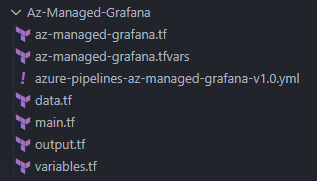COUNT AND IF ELSE WITH TERRAFORM AND DEVOPS:-
Greetings my fellow Technology Advocates and Specialists.
In this Session, I will demonstrate, Count and If Else with Terraform and DevOps by deploying Azure Managed Grafana.
- Azure Subscription.
- Azure DevOps Organisation and Project.
- Service Principal with Required RBAC ( Contributor) applied on Subscription or Resource Group(s).
- Azure Resource Manager Service Connection in Azure DevOps.
- Microsoft DevLabs Terraform Extension Installed in Azure DevOps and in Local System (VS Code Extension).
| OUT OF SCOPE:- |
| Azure DevOps Pipeline Code Snippet Explanation. |
| If you are interested to understand the Pipeline Code Snippet, please refer my other blogs in Terraform Series. |
| HOW DOES MY CODE PLACEHOLDER LOOKS LIKE:- |
 |
| AZURE DEVOPS YAML PIPELINE (azure-pipelines-az-managed-grafana-v1.0.yml):- |
trigger
none
######################
#DECLARE PARAMETERS:-
######################
parameters:
- name: SubscriptionID
displayName: Subscription ID Details Follow Below:-
default: 210e66cb-55cf-424e-8daa-6cad804ab604
values:
- 210e66cb-55cf-424e-8daa-6cad804ab604
- name: ServiceConnection
displayName: Service Connection Name Follows
…
















